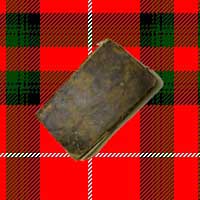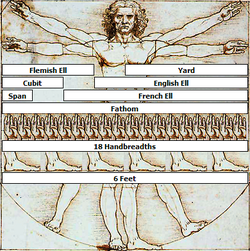
Bestselling book of the 18th and 19th centuries
home

Units of Measure |
|
From A cyclopædia of commerce, mercantile law, finance, commercial geography page 471. Weights and Measures. The employment of some sort of standards by which to measure and compare the specific gravities and magnitudes of different articles, must, at a very early period, have been seen to be indispensable to the easy and accurate arrangement of commercial transactions. The earliest standards of lineal measure seem to have been, for the most part, derived from portions of the human body: as the cubit, or length of the arm from the elbow to the, tip of the middle finger; the foot; the ulna, arm, or yard; the span; the digit, or finger; the fathom, or space from the extremity of the one hand to the extremity of the other when they are both extended in opposite directions ; the pace, &c.— Larger spaces were estimated by measures formed out of multiples of the smaller ones; and sometimes in days' journeys, or by the space which it was supposed a man might travel in a day, using a reasonable degree of diligence. ENGLAND.Measure of Length.—The ell = 45 inches. Wine Measure.—The gallon equal 4 quarts, 8 pints, or 32 gills, and contained 231 cubic inches, or 3.785 French litres. Of these gallons the anker contained 10, the rundlet 13. the tierce 42, the hogshead 63, the puncheon 84, the pipe or butt 126, and the tun 252. The Imperial gallon contains 277.274 cubic inches; therefore 1 wine gallon equal 0.833111 Imperial gallon; and 1 Imperial gallon equal 1.200320 wine gallon. The wine gallon is thus almost exactly ⅕th less than the Imperial; or 5 Imperial gallons equal 6 wine gallons. Hence, to convert wine gallons into Imperial gallons, deduct ⅕th from the former. Again to convert Imperial gallons into wine gallons, add ⅕th to the former; and to convert prices per Imperial gallon into prices per wine gallon, deduct ⅕th from the former. Ale and Beer Measure.—The gallon divided in the same manner as the wine gallon, and equal 282 cubic inches, or 4.6209 French litres. Of these gallons the firkin contained 9, the kilderkin 18, the barrel 36, the hogshead 54, the puncheon 72, the butt 106, and the tun 216. One ale gallon equal 1.017045 Imperial gallon; or 1 Imperial gallon equal 0.983241 ale gallon; hence approximately 59 ale gallons equal 60 Imperial gallons. Heaped Measure—The bushel 19½ inches wide from the outside, 8 inches deep, and measuring 2217.6 cubic inches; but when heaped in the form of a cone above the brim, 2815½. Three heaped bushels made a sack, 12 sacks a chaldron, and 21 chaldrons a score. This measure was used for coals, culm, lime, fish, potatoes, and other commodities. Apples and pears were commonly sold by the Winchester bushel heaped. Winchester or English Standard Corn Measure.—The denominations of this measure were the same as the Imperial. The Winchester bushel contained 2150.42 cubic inches, or 35.237 French litres. The Imperial bushel contains 2218.192 cubic inches; hence 1 Winchester bushel or quarter equal 0.969447 Imp. bushel or quarter, and 1Imp. bushel or quarter equal 1.031516 Winchester bushel or quarter; or approximately 33 Winchester bushels or quarters equal 32 Imperial. SCOTLAND.Measure of Length.—The standard Scottish ell of 36 Scots or 37.0598 Imperial inches. 6 ells made 1 fall; 40 falls 1 furlong; and 8 furlongs or 1920 ells made 1 mile, equal 1976.522 Imperial yards. Hence 10 Scots miles equal 11½ Imperial or statute miles nearly. The chain of l00 links, used for land measure, was equal to 24 ells, 74.1196 Imperial feet, or 1.123024 Imperial chains. Weights.—The standard Scottish Troyes or Dutch pound of 16 ounces, or 256 drops, equal 7608.95 troy grains, or about 1/12th heavier than the avoirdupois pound. The Lanark stone contained 16 of these pounds, or 17.391885 lbs. avoirdupois. The Scottish tron weight used for butter and cheese varied in different places. The standard Scottish meal boll contained 8 stones Dutch, or 139.135 lbs. avoirdupois; but usually reckoned 140 lbs. In consequence of the Dutch or Lanark stone being estimated at 171 lbs. avoirdupois. Liquid Measure.—The Scots gallon of 8 pints, 16 chopins, 32 mutchkins, or 118 gills, equal 3.00651, or rather more, than 3 Imperial gallons. The Scots anker of 20 pints equal about 7½ Imp. galls. Measures of Surface.—36 square ells equal 1 square fall, 40 square falls equal 1 rood, and 4 roods equal 1 acre, equal 1.261183 Imperial acre. To convert, therefore, Scots acres into Imperial, multiply by 1.261183; and to convert Imperial acres into Scots, multiply by 0.792906. Approximately, 23 Scots acres equal 29 Imperial acres; or more nearly, 134 Scots acres equal 169 Imperial acres. Hence Scots acres are convertible into Imperial acres by multiplying the number of the former by 169, and dividing the product by 134. On the other hand, Imperial acres are convertible into Scots acres by multiplying by 134, and dividing the product by 169. Similarly to convert prices of land per Scotch measure into prices per Imperial, multiply the former by 0.792906; or approximately deduct ⅕th, or more nearly 4s. l¾d. per £1from the Scots price. Again, to convert Imperial prices into Scots, multiply the former by 1.261183; or approximately add ¼th, or more nearly 5s. 2¾d. per £1 to the Imperial price. Grain Measures.—See the article Boll. A peck is an imperial and U.S. customary unit of dry volume, equivalent to 2 gallons or 8 dry quarts or 16 dry pints. Two pecks make a kenning (obsolete), and four pecks make a bushel. In Scotland, the peck was used as a dry measure until the introduction of imperial units as a result of the Weights and Measures Act of 1824. The peck was equal to about 9 litres (in the case of certain crops, such as wheat, peas, beans and meal) and about 13 litres (in the case of barley, oats and malt). A firlot was equal to 4 pecks and the peck was equal to 4 lippies or forpets. Special Measures of Length.—The hand = 4 inches; the pace = 5 feet; and the fathom = 6 feet. The geographical degree = 20 nautical leagues, or 69.121 miles. In land measure, the chain of 100 links = 66 feet. The Terms recognised in the different divisions of the United Kingdom for leases and money-payments are as follow:— In England and Ireland: Lady Day, March 25; Midsummer, June 24; Michaelmas Day, September 29; and Christmas, December 25. In Scotland: Candlemas, February 2; Whitsunday, May 15; Lammas, August 1 ; and Martinmas, November 11. When any of these falls on Sunday, the following Monday is considered to be the Term Day. France.Measures and Weight!.—The Imperial measures and weights are employed in government transactions, but the old system of France is that in ordinary use. The common practical equations are, 15 French feet - 16 British feet; 7 aunes = 9 British yards; 1 arpent = 1 British acre, 7 perches; 1 velt = 2 old English wine gallons, and 30 velts = 1 cask; the quintal of 100 lbs. French poids de marc = 108 lbs. avoirdupois, and 20 quintals - 1 French ton.
|